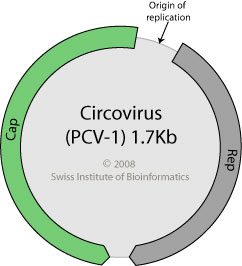

FDA recently received information from Merck & Co, Inc. that its preliminary studies have identified fragments of DNA from PCV1 and from a related porcine circovirus type 2 (PCV2) in its RotaTeq vaccine. Merck€™s findings suggest that the number of PCV DNA fragments in its vaccine may be smaller than what has been found in Rotarix.
FDA has so far not recommended suspension of RotaTeq use. The Vaccines and Related Biological Products Advisory Committee meets today, after which FDA will make further recommendations on the use of the licensed rotavirus vaccines in the United States.
The source of porcine circovirus type 1 DNA in both Rotarix and RotaTeq is likely to be trypsin used during propagation of the cell cultures necessary for vaccine production. The enzyme is produced from porcine pancreas.
Update 10 May 2010: The FDA has posted a briefing document for the VRBPAC meeting that was held this past Friday. The Los Angeles Times reports on the outcome of the meeting:
Members of a Food and Drug Administration advisory committee meeting Friday urged physicians to continue using both commercial rotavirus vaccines despite evidence that both carry trace contaminants from a harmless pig virus. The panel did not take a formal vote on a recommendation, but a majority of participants said they thought the benefits of the vaccine far outweigh any potential risk. An agency spokeswoman said it would make no immediate recommendation on the vaccines, but would act expeditiously to come to a decision.
Finally, there are some good quotations from committee members in the article at Medscape Today.

Pingback: Tweets that mention Porcine circovirus DNA found in RotaTeq -- Topsy.com
Few questions regarding trypsin, the suspected source of contamination: is it usually produced in-house by vaccine manufacturers or bought from external suppliers? If yes, are there many different ones?
How widely is trypsin used in production of biologicals? Should we be checking other products that are manufactured using trypsin?
Trypsin for cell culture is usually purchased from suppliers, and
there are many. Any biological that is produced in cell culture could
contain porcine circovirus 1 from the trypsin used. The alternative
would be to use non-enzymatic methods for dissociating cells, which
would avoid the trypsin.
I see that trypsin is used in baby food to help babies digest is better. Is it possible that porcine circovirus can be in this as well? Thank you.
Nevermind. One of my friends told me that since it is cooked, the virus will be destroyed. You have to admit, this can not be kosher.
It's not kosher in any sense of the word to have viral contaminants!
Pork or otherwise, if you understand my meaning.
Grant, I replied on the sciblog site you linked to, but it's not appearing.
Thanks for that. I see it has now turned up on his blog, rather than at sciblogs. (It's confusing how his commenting is set up!)
FWIW, I generalised my earlier comment at sciblogs. Most readers there are media and public, not scientists and I didn't want to make the argument too fiddly. (Ifs and buts look bad, etc.) I'm never sure if this is right way to go about it, but there you go.
I saw your earlier post before I wrote to you. It's very interesting and I was (am?) tempted to blog about it myself. I'd be curious on your opinion if for the general public it helps to separate the “evolutionary time scale” events from shorter-term “public health risk level” events? (Even though with viruses this isn't entirely possible.)
Pingback: A DNA virus with the capsid of an RNA virus
Pingback: Why Don’t People Vaccinate? | The Common Room